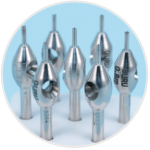Blade, Needle holders
Surgical blade holders & Needle Holder are the Hemostatic Forceps guarantee accuracy, security, and effectiveness during surgical procedures, making them an essential instrument in modern medicine. These tools are made to firmly keep surgical needles in position so that doctors may reliably execute delicate procedures and produce precise cuts.
The Surgical needles jaws can be straight or curved, and it comes in a range of sizes and forms. Most Needle Holder forms have a notch lock to maintain their position. The jaws of needle holders might be underrated or serrated, longer or shorter.
Its durability in the holder determines the needle's productivity. It is necessary to set the needle holder jaws to the needle's size in order to grip the needle firmly and stop it from moving or bending. A larger needle body cross-section usually results in a greater surface contact with the jaws of the needle holder and a greater needle twisting moment.
Surgical Needle Holders:
Getting a firm grip on the needle is the first step in inserting it into the needle holder. You can use your fingertips, a pair of smooth forceps, or an additional needle holder for this. The fastest method is usually to handle the needle with the fingertips rather than a tool; however caution is required to prevent harm.
Avoid reaching straight for the needle; this is probably the best method to ensure that you will be hurt. Alternatively, it is quite safe to hold the thread between your thumb and index finger, away from the needle, and then use your other hand to drag the needle backward until the swage touches your fingertips.
Once in the proper position for the planned pass, the needle may be put into the needle holder with good control. Because there is no penetrating forward force exerted to the needle's tip, pulling the swaged end of the needle back towards the hand will not result in damage.
Although correctly putting the needle into the needle holder may seem like an insignificant oversight, incorrect loading can result in serious and preventable issues. The initial loading of the needle into the needle holder is frequently done by the scrub nurse, but as the suturing continues, the surgeon frequently needs to refill it on the surgical field.
A Surgical Blade Holder: What Is It?
A surgical blade holder is a tool used during surgery to hold a scalpel blade or other sharp object. Because of its stability and control, the surgeon may perform accurate cuts and incisions with less chance of damaging nearby tissues. The surgeon can effectively execute intricate procedures and reach hard-to-reach places thanks to the holder's adjustable angles and placements.
Surgical Blade Holder Applications
A variety of medical procedures include the use of surgical blade holders, such as:
- Neurosurgery: Surgical blade holders are essential for creating accurate incisions in the brain and spine during neurosurgery. These cuts are essential for gaining access to certain nervous system regions, removing tumours, releasing pressure from pinched nerves, and fixing broken blood vessels. By minimizing the possibility of harm to the fragile brain tissue, the blade holder enables the surgeon to achieve the best possible outcome for the patient.
- Cardiothoracic surgery: During a variety of operations, including heart valve replacement and coronary artery bypass grafting, surgical blade holders are essential tools in cardiothoracic surgery. By lowering the possibility of problems and enhancing patient outcomes, the blade holder helps the surgeon to precisely and securely reach the heart and surrounding veins.
- Gastrointestinal surgery: In order to make accurate incisions in the abdomen wall and make it easier to reach the digestive organs, surgical blade holders are frequently utilized. For example, the blade holder makes microscopic incisions in the abdomen during a laparoscopic cholecystectomy and removes the gallbladder from the surrounding tissue.
- Plastic surgery: When performing a variety of cosmetic treatments, including facelifts, breast augmentations, and rhinoplasties, plastic surgeons use surgical blade holders to produce accurate incisions.
- Ophthalmology:Surgical blade holders are necessary for making incisions in the eyes during a variety of ophthalmology operations. Among the most popular uses is cataract surgery, in which the intraocular artificial lens is replaced with a clouded one by making a tiny incision in the cornea with the blade holder. In order to promote drainage and lower intraocular pressure, the blade holder is also employed in the treatment of glaucoma.
Surgical blade and needle holders are indispensable for a variety of medical operations, providing both patients and surgeons with a multitude of advantages. Their accuracy and adaptability make them invaluable in contemporary medicine, from gastrointestinal surgery to neurosurgery. We anticipate surgical blade and needle holders to become even more advanced as technology develops, allowing surgeons to carry out difficult surgeries more precisely and safely.

 FUE Punch – best hair transplant punch
FUE Punch – best hair transplant punch